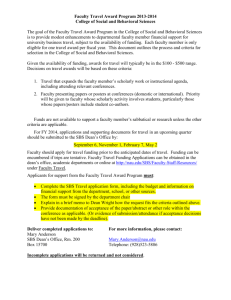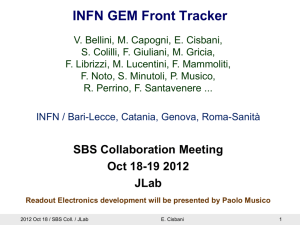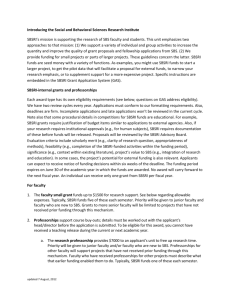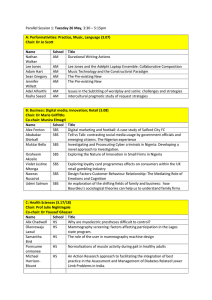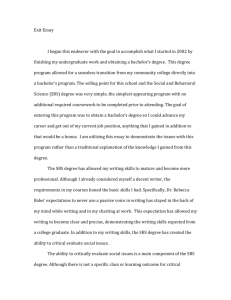26/Oct/2013
advertisement
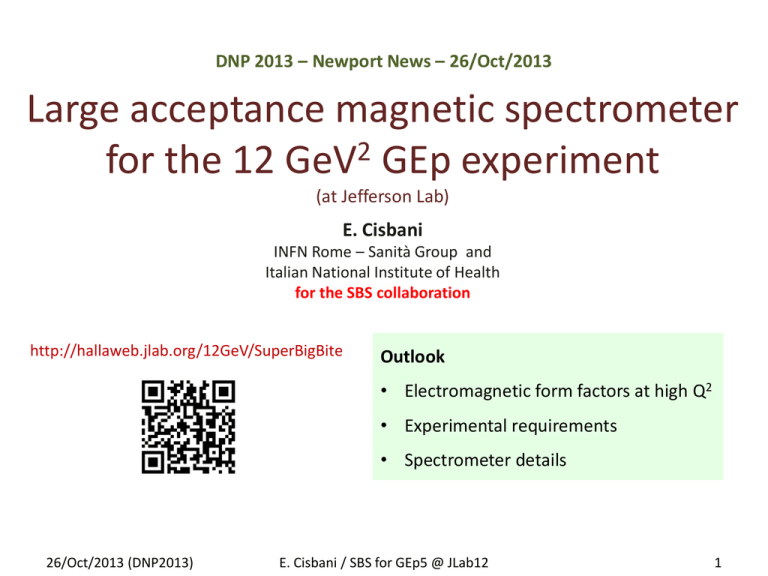
DNP 2013 – Newport News – 26/Oct/2013 Large acceptance magnetic spectrometer for the 12 GeV2 GEp experiment (at Jefferson Lab) E. Cisbani INFN Rome – Sanità Group and Italian National Institute of Health for the SBS collaboration http://hallaweb.jlab.org/12GeV/SuperBigBite Outlook • Electromagnetic form factors at high Q2 • Experimental requirements • Spectrometer details 26/Oct/2013 (DNP2013) E. Cisbani / SBS for GEp5 @ JLab12 1 Form Factors: discovery and formalism • R.W. McAllister, R. Hofstadter Phys. Rev. 102 (1956) 851 “First measurement of the proton electromagnetic radius”: RMS E/M radius of =(0.74 ± 0.24) 10-13 cm Nucleon electromagnetic current operator has two “unknown” functions (Dirac and Pauli FFs) that describe the internal structure of the nucleon (one photon exchange approx.): In terms of Sachs FFs: Sachs FFs are FT of the charge and magnetization distributions in the nucleon (in Breit frame) Elastic Cross section (Rosenbluth): 26/Oct/2013 (DNP2013) E. Cisbani / SBS for GEp5 @ JLab12 2 Proton GE/GM – an «unexpected» discrepancy d 2 2 GEp GMp d Rosenbluth Separation: assume single photon approximation Prior to JLab/2000, expectations were that proton GE/GM fairly constant with Q2 GEp GMp Pt ( Ebeam Ee ) tan e Pl 2M p 2 Polarization transfer from the incident electron to the scattered proton At JLab, new class of experiments show proton GE/GM decreasing linearly with Q2 Two Photon Exchange – favorite candidate 26/Oct/2013 (DNP2013) E. Cisbani / SBS for GEp5 @ JLab12 DA3: T. Averett HA2: M. Kohl 3 Proton GE/GM - Theoretical models • Many theoretical models – VMD (Iachello, Lomon, Bijker), generally good description of all FF – Relativistic CQM (Miller, Gross, ...) spin dependent quark density – Lattice QCD, start to give prediction – Dyson-Schwinger, dressed quarks, diquark correlation, ... – pQCD-based: GE/GMconst Q2 – GPD-based: direct connection to quark OAM, FF’s constraint GPD’s Most of them agree with current data but diverge at higher, unexplored, Q2 26/Oct/2013 (DNP2013) E. Cisbani / SBS for GEp5 @ JLab12 4 «Modern» Form Factor measurements at high Q2 Method: Polarization Transfer: 𝒑 𝒆, 𝒆′𝒑 Target Perp. Polarization: 𝒑↑ 𝒆, 𝒆′ 𝒑 𝑝 Measure 𝐺𝐸 𝑃𝑡 𝜃 tan ∝ 𝑝 𝑃𝑙 2 𝐺𝑀 (one photon approx.) Pt, Pl : trans. and long. polarization of the recoil proton 𝑝 𝐴= 𝑁+ −𝑁− 𝐺𝐸 ~ 𝑁+ +𝑁− 𝐺 𝑝 𝑀 N+ and N- : events with opposite transverse target polarization Many systematics effects (theory and exp.) cancel in ratio Figure of Merit (stat.) : acceptace L: Luminosity : elastic xsec ~ 𝐸 2 𝑄12 Pb: beam polarization Ω L σ Pb2 PT2 Ω L σ Pb2 ϵ A2y 𝛀𝐋𝛜 ~ 𝐐𝟏𝟔 Ay: polarimeter analyzing power ϵ: polarimeter efficiency 𝛀𝐋 𝟐 ~ 𝟏𝟐 𝐏𝐓 𝐐 PT : Target polarization At Q2~10 GeV2 expected: FoMpol_trans ~ 10 FoMtarg_pol (target polarization cannot tolerate large L) Challenges at high Q2: Maximize (coincidence) acceptance Maximize luminosity ... keeping costs at «affordable» level Mazimize polarization efficiency Maximize beam polarization (... having the needed beam energy) 26/Oct/2013 (DNP2013) E. Cisbani / SBS for GEp5 @ JLab12 5 Jefferson Lab - CEBAF after 2013 add Hall D (and beam line) 6 GeV CEBAF (< 2013) Max Current: 200 A Max Energy: 0.8 - 5.7 GeV Long. Polarization: 75-85% Upgrade magnets and power supplies CHL-2 12 GeV CEBAF (>2013) 26/Oct/2013 (DNP2013) Max Current: 90 A Max Energy Hall A,B,C: 10.9 GeV Max Energy Hall D: 12 GeV Long. Polarization: 75-85% 6 E. Cisbani / SBS for GEp5 @ JLab12 Proton GE/GM at large Q2 by polarization transfer (SBS) Beam: Current= 75 A, Polarization= 85% long. Energy= 6, 8 and 11 GeV Target: H2 Liquid Length= 40 cm Luminosity = 8 · 1038 Detectors: GEp5 experiment in HallA P-arm: SBS + Polarimeter E-arm: BigCal + Coordinate GOAL: Extend the measurement of the proton form factor ratio GE/GM to the maximum Q2 that is possible with 11 GeV beam with constraints: Absolute error < 0.1 Beam time = 60 days 26/Oct/2013 (DNP2013) E. Cisbani / SBS for GEp5 @ JLab12 7 New SuperBigbite Spectrometer (SBS) in Hall A Large luminosity “Large” acceptance Forward angles Reconfigurable detectors High photon up to 250 MHz/cm2 and electron 160 kHz/cm2 background • Support event rate 10x higher than with standard small acceptance spectrometer • GEM chambers to handle the high rate of the background 26/Oct/2013 (DNP2013) E. Cisbani / SBS for GEp5 @ JLab12 8 Large Luminosity Large Background Hit • Must be supported by the detectors GEM technology • Must be handled by the trigger: – spatial and time correlation between electron and proton elastically scattered – «high» energy threshold in segmented CALO’s Good tracking resolution needed - momentum resolution: 1 % - angular resolution: 1 mrad - vertex reconstruction: 5 mm Red: p0 photoproduction Black: Elastics Blue: Sum For Emiss<0.35 GeV, remaining p0 background: 10% Adequate proton polarization precession reconstruction (next slide) 26/Oct/2013 (DNP2013) E. Cisbani / SBS for GEp5 @ JLab12 9 GEp5: Proton Polarimeter (PP) Number of scattered protons: Use azimuthal asymmetry of the proton scattering off matter induced by spin-orbit coupling where refers to electron beam helicity A (a.u.) Pypp Pxpp Track inTrack in Track out Track out Polarimeter only measures components of proton spin that are transverse to the proton’s momentum direction Maximize Pe N=number of scattered proton, Pe beam polarization Require: Dipole magnet to precess Pl at target to Pypp 26/Oct/2013 (DNP2013) E. Cisbani / SBS for GEp5 @ JLab12 10 SBS Dipole Magnet / 48D48 from BNL Magnet Parameters Integral field strength 1.82 T-m 2.28 T-m with pole shims Yoke length 1.22 m Gap: 47 cm 121.9 cm Yoke Weight 85 tons 6 1008 steel sectors, largest is 18.3 tons (deg) (mrs) 5 12 15 72 30 76 Beam Magnetic field needed for: • Momentum measurement • Polarimetry • Sweep off low energy charged particles 26/Oct/2013 (DNP2013) Yoke modifications to allow beam pipe passage at forward angle kinematics E. Cisbani / SBS for GEp5 @ JLab12 Adapted from Robin Wines / JLab 11 GEM Working principle Recent Technology: F. Sauli, Nucl. Instrum. Methods A386(1997)531 GEM foil: 50 m Kapton + few m copper on both sides with 70 m holes, 140 m pitch Ionization Multiplication Multiplication Strong electrostatic field in GEM holes Multiplication Readout Support high particle flux (≫ MHz/cm2) Intrinsic resolution at 50 m level Relatively unexpensive SBS Robust / Slow aging 26/Oct/2013 (DNP2013) E. Cisbani / SBS for GEp5 @ JLab12 Gain vs Particle Flux 12 SBS - GEM Front Tracker • • • Six 150x40 cm2 chambers with small dead area (~10%) Each chamber consists of 3 50x40 cm2 lightweight 3xGEM modules with x/y strip readout (0.4 mm pitch) Readout electronics based on high channel density APV25 ASIC driven by VME64x modules Use x/y charge correlation for false hit suppression Large SNR 26/Oct/2013 (DNP2013) E. Cisbani / SBS for GEp5 @ JLab12 13 GEM Front Tracker MonteCarlo Realistic MC and digitization • Tracking efficiency 99%-85% depending on background • Track parameter resolutions at acceptable values even at largest background 26/Oct/2013 (DNP2013) E. Cisbani / SBS for GEp5 @ JLab12 14 CH2 Polarimeters with GEM tracking • • Two Polarimeters in series to increase statistics by ~50% Each polarimeters consists of CH2 analyzer (50 cm) and four 50x2000 cm2 GEM chambers Each chamber is made of five 50x50 cm2 GEM modules Similar design of GEM front tracker, optimized for focal polarimetry (less demanding particle rate respect to main tracker) Number of scattered protons • • qpp (deg) N. Liyanage et al. / UVa 26/Oct/2013 (DNP2013) E. Cisbani / SBS for GEp5 @ JLab12 15 PJ6: B. Quinn G. Franklin et al. / Carnegie Mellon 26/Oct/2013 (DNP2013) E. Cisbani / SBS for GEp5 @ JLab12 16 High Luminosity, impact on Trigger / DAQ • Must efficienty select electron elastic scattering by DJ4: A. Camsonne angular correlation • First level (L1) from electron arm – Energy information (with cuts to reduce inelastic) – Rate (from SLAC high energy data and RCS experiments): Ethr/Emax % • Hadron Arm: Rate [kHz] 50 75 85 90 1400 203 60 38 – Energy information (with cuts to reduce inelastic) – Rate: 1.5 MHz • Second level (L2) from two-arm coincidence: – in 30 ns gate: 9 kHz – AND geometrical correlation: 2 kHz 26/Oct/2013 (DNP2013) E. Cisbani / SBS for GEp5 @ JLab12 17 Conclusions Expected results on proton GE/GM Kinematics and expected accuracy E (GeV) Q2 (GeV2) Days DGE/GM 6.6 5.0 1 0.023 8.8 8.0 10 0.032 11.0 12.0 30 0.074 http://hallaweb.jlab.org/12GeV/SuperBigBite SBS, is a cost effective, new magnetic spectrometer; will use the recent GEM technology to operate at high luminosity, providing “large” acceptance and high reconstruction accuracy SBS will permit unprecedented measurements of the proton and neutron Form Factors at high Q2 as well on SIDIS physics NC9: A. Puckett 26/Oct/2013 (DNP2013) E. Cisbani / SBS for GEp5 @ JLab12 18

